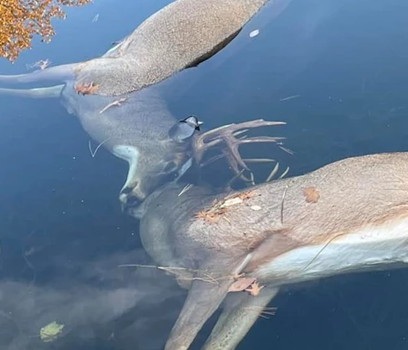Deadly Duels In Nature
Fall 2025
By Terry W. Johnson
Wildlife dramas take place in Monroe County throughout the year. However, few are more intense and dramatic as fights between white-tailed deer bucks. Dr. Bruce Huckaby recently took amazing photographs of two bucks that apparently died after they locked antlers during such an altercation.
Even deer hunters that spend more time in the woods than most other Monroe Countians rarely witness fights between whitetail bucks. It is even more uncommon to come across fighting bucks that have locked antlers. Typically, the only evidence that such a battle has taken place is the skeletal remains of two bucks that were never able to pry themselves apart.
There have many cases where people have tried to free two bucks with locked antlers. Some of these efforts have been successful when bucks, so worn out from fighting, rescuers were able to saw off their tangled antlers. This is risky business at best. Good Samaritans have been rewarded for their efforts by suffering bodily injury or even been charged by the deer they just freed.
These fights do not last long; typically, most are over in only a few minutes. Prolonged bouts enhance the chance of the combatants injuring one another or locking antlers. If two bucks lock antlers, they are in real trouble.
During a fight, predators such as coyotes have attacked bucks that have locked antlers. Prolonged combat also increases the chance of suffering an injury such as being gored. Injuries are more likely when a third buck joins the Fray. Both internal and external injuries incurred during a fight can later become infected and result in the death of a buck long after a battle is over. Another often-overlooked downside to prolonged fights is bucks deplete stored fat in their bodies. Bucks need this energy to survive the rigors of winter.
The bucks photographed by Dr. Huckaby apparently had the rare misfortune of tumbling in the water as they struggled to pull free from one another. Bucks experiencing such a fate usually quickly drown.

Although not the bucks Dr. Huckaby photographed, this image proves that fights ending in the water happen all too often.
More often than not, deer with locked antlers die of starvation.
Bucks begin fighting in the fall after they have shed the velvet that has covered its antlers. At this time of the year, their testosterone levels are on the rise and the breeding season will soon begin. Aggression, including fighting, is more prevalent when does and ready to breed.
The bucks that are most likely fight are those that are of similar size and strength. Bucks with well-developed curved antlers are most apt to become entangled than those adorned with straighter racks. When bucks lock antlers, and try to push their adversary backwards; literally hundreds of pounds of thrust are directed at the antlers. This often results in the antlers spreading apart ever so slightly. When the antlers return to their normal position, they are sometimes entangled.
Thousands of years ago, Native American hunters discovered that the sound of clashing of antlers attracts other deer. The savvy hunters used this knowledge to their advantage and began using antlers to “rattle” deer close enough to shoot them. Seeing the advantage using antlers to simulate the sound of two bucks fighting, European colonists were quick to adopt the technique. Rattling deer is practiced by hunters to this day.
Finding the remains bucks that lost their lives when their antlers became impossibly tangled during a fight is something that is impossible to forget. However, we should keep this form of mortality is perspective. Fortunately, very few deer succumb to this fate. Far more deer are killed by motor vehicles, predators, diseases, and hunters. There is no way to prevent whitetail buck from fighting and occasionally locking antlers. Indeed, the sound of clashing antlers will be reverberating across the Monroe County for generations to come.
Terry Johnson is a past Director of the Georgia Department of Natural Resources, non-game wildlife program and a member of the Georgia Outdoor Writers Association. He makes his home in Forsyth and can be contacted at tjwoodduck@bellsouth.net.